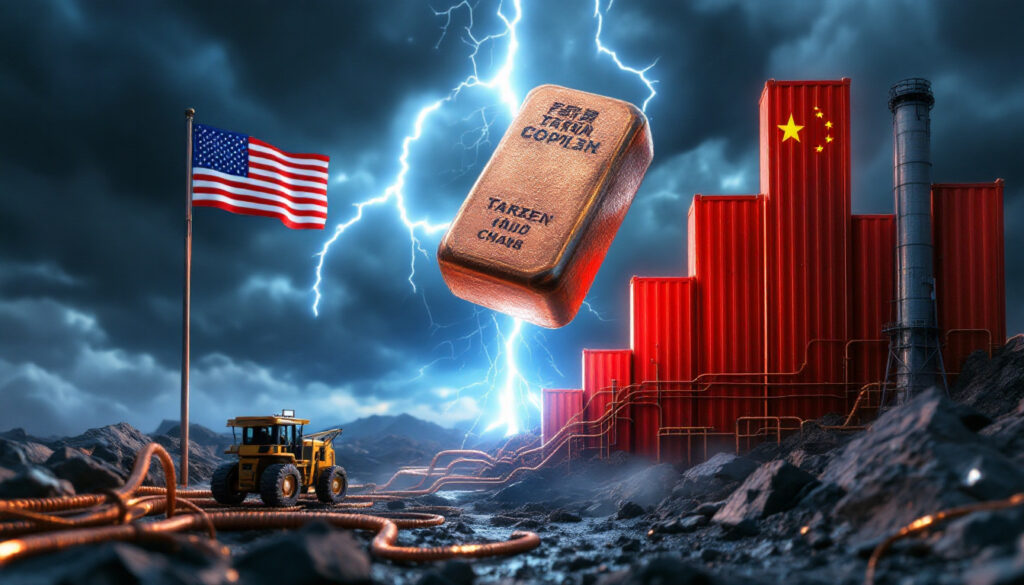Copper Plunges as Tariffs Hammer Metals and Mining Markets
The global copper market experienced a significant downturn in early April 2025, with prices plummeting more than 5% to trade below $9,000 a ton. This marked the most substantial single-day decline since July 2022, creating shockwaves across the metals and mining sector. The dramatic price movement has sparked concerns among investors, miners, and industrial consumers about the stability of metal markets amid escalating Trump's trade policies and international tensions.
What Caused the Recent Copper Price Crash?
The copper market's dramatic decline was triggered by a perfect storm of geopolitical and economic factors, with trade tensions taking center stage in the global commodities narrative.
The price crash occurred when copper plunged 5.1% to $8,890.50 a ton in London trading, shocking market participants who had maintained bullish sentiment through the first quarter of 2025. By mid-day London trading, copper prices settled slightly higher at $8,916.50 a ton, still down 4.8% for the session.
This severe reaction came in response to escalating trade tensions between the world's largest economies. US President Donald Trump imposed sweeping tariffs on all incoming goods, disrupting established trade patterns and sparking immediate retaliation from China, which announced a 34% tariff on all US imports effective April 10, 2025.
"The market was caught completely off guard by the scope and scale of these tariff announcements," noted Max Layton, global head of commodities research at Citigroup Inc. "We're seeing panic selling as traders reassess demand forecasts across all industrial metals."
The Trade War Escalation Timeline
The sequence of events leading to the copper crash followed a rapid progression:
- President Trump announced comprehensive tariffs on imported goods
- China responded with plans for 34% retaliatory tariffs on US imports
- Traders began liquidating positions across industrial metals
- Copper prices broke below the psychologically important $9,000 level
Market participants were particularly alarmed by the sudden shift from targeted tariffs to blanket trade barriers, which dramatically increased uncertainty about global copper market trends and industrial activity.
Key Price Movements and Market Reactions
Copper's decline was part of a broader metals market selloff:
- Copper is tracking toward an 8%+ weekly decline – the worst performance since the early pandemic
- Aluminum prices fell for 12 consecutive trading days, breaking technical support levels
- Zinc dropped 3.2%, while lead and nickel suffered losses of 2.8% and 2.5% respectively
- The Bloomberg Industrial Metals Subindex entered correction territory, falling over 10% from recent highs
"The selloff has taken on momentum characteristics, with technical breaks accelerating the downward pressure," explained senior metals strategist Marcus Thompson at Capital Economics. "We're seeing forced liquidation from leveraged positions across the metals complex."
How Are Mining Companies Being Affected?
The metals price crash has sent shockwaves through mining equities, with major producers experiencing substantial share price declines as investors reassess profit outlooks and project viability.
Mining Stock Performance
The market reaction hit mining stocks guide parameters particularly hard:
- Glencore shares plummeted nearly 10% to their lowest level since 2021
- Antofagasta, a Chilean copper specialist, lost approximately 9% of its value
- Freeport-McMoRan, a major US copper producer, saw its stock drop 8.2%
- Rio Tinto and BHP, diversified mining giants, declined 6.5% and 7.1% respectively
The FTSE 350 Mining Index registered its largest one-day percentage decline in three years, reflecting widespread investor concern about the sector's near-term prospects.
"Mining equities are pricing in a prolonged period of lower metals prices and margin compression," noted Sarah Jenkins, mining analyst at JP Morgan. "Companies with high operational leverage to copper are facing the steepest declines as investors discount future earnings potential."
Industry Expert Perspectives
Market analysts have rapidly adjusted their outlooks in response to the price movements:
Max Layton of Citigroup predicted copper would likely fall by another 8% to 10% in coming weeks as the market fully digests the implications of trade barriers on industrial demand.
Goldman Sachs analysts maintained their long-term bullish thesis while acknowledging near-term challenges: "While we remain structurally bullish on copper in the long run, weaker global GDP and copper demand growth risk delaying the deficit we expect to see in the market this year."
Industry insiders note that companies are already implementing contingency plans, with some miners considering production cuts at higher-cost operations if prices remain depressed. Meanwhile, Rio Tinto's copper strategy continues to focus on long-term growth despite short-term market volatility.
What's Driving the Market Volatility?
The copper market has experienced a dramatic shift in sentiment, transitioning from supply-focused optimism to demand-side anxiety in a matter of days.
Supply vs. Demand Dynamics
Prior to the tariff announcements, copper traders were focused primarily on bullish supply-side factors:
- Mine disruptions in Chile and Peru had tightened concentrate availability
- US importers were rushing shipments to beat potential targeted tariffs
- Low global exchange inventories suggested physical tightness
- Anticipated Chinese stimulus was expected to boost consumption
However, the broader tariff announcements abruptly shifted market focus to demand concerns:
- Trade barriers threaten to reduce industrial activity in both the US and China
- Manufacturing sectors, major copper consumers, face increased uncertainty
- Construction activity, accounting for roughly 28% of copper demand, may slow
- Supply chain disruptions could reduce fabricator operations globally
"What we're witnessing is a complete reversal in market psychology," explained copper market veteran Michael Chen of Metal Focus. "The narrative has flipped from 'not enough supply' to 'where will the demand come from?' almost overnight."
Global Economic Implications
The market reaction reflects broader concerns about global economic growth:
The trade war escalation threatens to reduce global GDP growth by an estimated 0.5-0.7 percentage points, according to preliminary economic models. This represents a significant headwind for industrial metals that are closely tied to economic activity.
Chinese markets were closed for the Qingming Festival holiday during the worst of the selloff, leaving traders anxious about the reaction when the world's largest metals consumer returns to trading.
"The absence of Chinese buyers during this critical price movement has created additional uncertainty," noted commodities strategist Elena Rodriguez. "Their response when markets reopen will be crucial in determining if we see stabilization or further declines."
What's Next for Copper and Industrial Metals?
Despite the current market turbulence, many analysts maintain a cautiously optimistic long-term outlook for copper, even as they brace for continued near-term volatility.
Short-Term Market Outlook
The immediate prospects for copper prices remain challenging:
- Citigroup predicts additional 8-10% price declines in coming weeks
- Trading desks report increased margin calls and forced liquidation
- Options market volatility has spiked to the highest level since March 2020
- Chinese buyer reactions after their market reopens will be closely monitored
Technical analysts point to $8,500 per ton as a critical support level that could trigger additional selling if breached. Conversely, a move back above $9,000 might signal stabilization.
"We expect choppy trading conditions to persist throughout Q2 as markets digest the full implications of these trade measures," said copper analyst James Wilson. "Liquidity could be challenged during periods of stress, creating opportunities for well-capitalized traders."
Long-Term Fundamental Factors
Beyond the immediate trade tensions, longer-term structural factors continue to support copper price dynamics:
- Goldman Sachs remains "structurally bullish" on copper's multi-year outlook
- The global energy transition requires substantial copper for electrification
- Mine development timelines of 7-10 years limit supply flexibility
- Ore grade deterioration at existing mines constrains production growth
"The current price correction doesn't change the fundamental supply-demand imbalance expected to emerge later this decade," explained resources analyst Katherine Palmer. "The energy transition alone is projected to increase copper demand by 30% by 2035, while the project pipeline remains insufficient to meet this growth."
Industry executives emphasize that while current prices create challenges, they also risk deterring investment in new projects, potentially exacerbating future supply deficits.
FAQ: Understanding the Copper Market Crash
Why is copper considered a bellwether metal for the global economy?
Copper's widespread use across multiple industries makes it an exceptional economic indicator. The metal is essential in construction (28%), electronics (17%), transportation (13%), power generation, and infrastructure development. Its conductivity, corrosion resistance, and durability make it irreplaceable in many applications, earning it the nickname "Dr. Copper" for its ability to diagnose economic health.
How do trade tariffs impact metal prices?
Trade tariffs affect metal prices through multiple mechanisms. They directly increase costs for importers, potentially reducing demand. More significantly, they disrupt established supply chains, create uncertainty about future economic growth, and force consumers to reconsider investment plans. This uncertainty leads investors to reduce exposure to industrial commodities, pressuring prices downward.
What other metals were affected by the recent market selloff?
All major industrial metals experienced significant declines:
- Aluminum fell for 12 consecutive trading days, reaching multi-year lows
- Zinc dropped 3.2% amid concerns about galvanized steel demand
- Nickel lost 2.5%, with battery demand projections being revised downward
- Tin and lead both declined by more than 2.5%
- Precious metals showed relative resilience, with gold benefiting from safe-haven flows
How might China's retaliatory tariffs affect global metal markets?
China's 34% tariff on US imports creates cascading effects across global metal markets. As the world's largest consumer of industrial metals, any slowdown in Chinese industrial production has outsized effects. The tariffs may redirect trade flows, with Chinese buyers seeking non-US sources and US producers facing pressure to discount domestic sales, creating regional price disparities.
What factors could stabilize or reverse the copper price decline?
Several developments could help stabilize copper prices:
- Major supply disruptions at key producing mines
- Signs of trade tension de-escalation between the US and China
- Stronger-than-expected economic data from major economies
- Additional stimulus measures, particularly infrastructure-focused spending
- Producer discipline in curtailing high-cost production
The physical market's tightness or looseness will ultimately determine price direction, with exchange inventory movements providing early signals of changing conditions.
Looking to Stay Ahead of Major Mineral Discoveries?
Discover why significant mineral finds can lead to exceptional market returns by exploring Discovery Alert's dedicated discoveries page, where their proprietary Discovery IQ model delivers real-time notifications on ASX mineral announcements, empowering you to make informed investment decisions before the broader market reacts.




